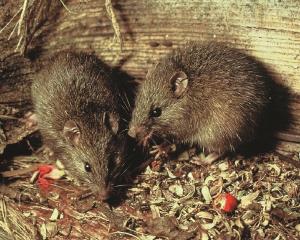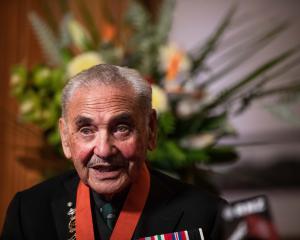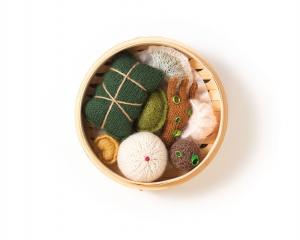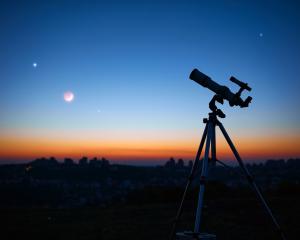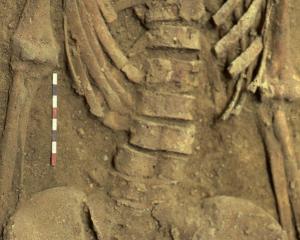
A visit by American author and runner Christopher McDougall shines a light on our potential for the heroic, writes Tom McKinlay.
Dave McLean has a particularly efficient-looking shuffle as he moves across the Middle Beach sands amid a 20-strong pack of runners.
Neither of his feet leave the ground for very long as he propels himself onward, onward.
He can propel himself onward for some distance, including Pheidippides' 42.2km and has done so previously around Otago Harbour during the running of the city's marathon.
For a man in his 60s that's an heroic effort by many measures.
But that's not the half of it.
Beset with issues common to men of a certain age, he rigged up a catheter tube last year to afford himself some relief while on the go.
Taped carefully in place at the top, it travelled down his leg to his shoe, then with a small extension, out a hole in the side.
His time, in the masters section, was a tick under 4 hours 20.
Next on the agenda is the 32km Routeburn Classic.
Mr McLean (62) is expecting it will be a close-run thing this year between himself and his daughter.
Men in their 60s are becoming increasingly competitive over longer distances, he says.
Halfway to the running pack's destination another joins in, Jenni Topliss (50), wearing what look like Roman sandals.
They are in fact Luna Sandals, the gold standard in "barefoot running'', if you are not actually in bare feet.
She says this particular pair have done about 600km, including a half-marathon.
Not satisifed with that, Ms Topliss is building towards a longer, colder running challenge, in Kangerlussuaq, Greenland in October.
Her Polar Circle Marathon challenge is actually a marathon one day followed by another half-marathon the next.
Both McLean and Topliss, and the rest of the pack, are heading towards the Octagon to hear a talk by writer Christopher McDougall, author of Born to Run and Natural Born Heroes, the former practically a sacred text for runners.
It's being made into a movie starring Matthew McConaughey.
McDougall, unofficial scribe of the barefoot running movement, is running too, when he's not stopping to have his photograph taken.
He also has a pair of Luna Sandals.
The writer is in town at the invitation of the Dunedin Writers and Readers Festival.
It's a fleeting visit, much of it spent running.
Already this morning he's been up Leith Valley running trails with, among others, barefooted local physiotherapist and running coach Dr Chris Sole.
McDougall will later comment that Dr Sole is one of just a handful of coaches around the world teaching running form.
Both McLean and Topliss say he's the reason they are still striding out.
McDougall's a big man, 195cm and 100kg, certainly the biggest of those running today but he's concentrating on leaving no bigger divots in the sand than anyone else.
He's concentrating on running like the Tarahumara, something he does often.
McDougall brought the Tarahumara to the attention of the world in 2009 with Born to Run, subtitle The hidden tribe, the ultra-runners and the greatest race the world has never seen.
They are the hidden tribe of the title and after almost 300 pages of kinetic, breathless exposition, host that great race.
An ancient indigeous Mexican people, they've been running forever, escaping conquistadors, drug cartels and assorted other pestilence and apocalypse.
As a result they are very, very good runners.
Fifty miles.
Just warming up.
Try 100.
And try it aged 80.
They call themselves the Raramuri, the running people.
Their effortless style is described in the book: "whish ... whish ... whish'' go their sandals, "a sound like a drummer beating rhythm with the brushes.
Their soles didn't hit the ground so much as caress it''.
But don't imagine singlets and name-brand running shoes.
Tarahumara run in full, bright shirts and sandals made from tyre rubber.
And forget the grim determination of the Olympic marathon.
"Such a sense of joy,'' another character from the book marvels, as a couple of tribesmen fly past, more than 50 miles through the punishing high-altitude ultradistance Leadville Trail 100.
It seemed that they had "never forgotten what it felt like to love running. They remembered that running was mankind's first fine art, our original act of inspired creation''.
Their sandals explain those McDougall is carrying and the ones worn by Topliss.
• Through the example of the Tarahumara, and others, Born to Run explores what we've lost and what is there to rediscover if people are prepared to pull on a pair of running shorts.
"I was always told that running is bad for the body: you need special shoes, you will get hurt if you run too much, it's bad for the knees. It's bad, bad, bad,'' McDougall says.
"And then I hear about this tribe, and these guys are twice my age running four times the distance I was told was the ultimate distance, you know, the marathon is the ultimate challenge. Well these guys in their 80s are running 100 miles at a time.''
The Tarahumara, he says, are more representative of the human animal than we are.
"We are the ones who are sagged into decay.''
But McDougall's not out to condemn.
"The way we live is symptomatic of the way in which we have evolved naturally,'' he says.
"We have bodies that are really wonderful for movement, but we have brains that are dedicated to conserving energy at all costs because you never know when the emergency is going to arrive.''
Unfortunately, in our cosseted modern world, the sabre-tooth never arrives.
Our bodies are never called to action.
And it's our bodies that should be in the action, as near to naked as possible, certainly from the ankle down.
Barefooters like McDougall have an unveiled contempt for the mainstream running-shoe industry.
You know the brands.
They are responsible, he says, for much of the pain and injury runners suffer.
Lose the shoes, he says.
We've been running on the wedge-shaped jogging sole for just a few decades.
The foot evolved to do the job over millions of years.
Once you've lost the shoes, keep running.
There's a Prof Dennis Bramble, a biologist at the University of Utah, quoted in Born to Run who says so well-suited are we to running, that all things being equal, a 64-year-old should still be punching out the same marathon times they did at 19.
Further proof, he says, that to be on the run is our natural condition.
So don't bet against Dave finishing first on the Routeburn.
That said, the same Prof Bramble's research shows there's little in it between men and women over longer stretches.
Results in ultramarathons back him up.
Dave's daughter's odds are good.
It also bodes well for Jenni in Greenland.
Evolution is the key here again.
We alone in the animal world can effectively regulate our body temperature through perspiration, allowing the early hominids to run down their prey over long distances, something only a couple of tribes anywhere still do.
In recent times, South African tracker Louis Liebenberg joined the Bushmen of the Kalahari for a "persistence hunt'', bagging a kudu after tracking it for miles under the desert sun.
It can still be done.
For his new book, Natural Born Heroes, McDougall dipped into the past again to discover further lost capacity, and found himself scrambling over the precipitous heights of Crete in an effort to unearth the secrets of the heroes of ancient Greece.
It's a rollicking yarn, roping in Nazis, Kiwi sharpshooters, kindergarten heroines, Odysseus and dissolute Englishmen just for starters.
But what it boils down to is another paean to human potential.
McDougall digs back into Plutarch, "the great Greek umpire of all things heroic'', who saw heroism as a "fantastic natural super-fuel: powerful and abundant and just waiting to be harnessed''.
Then he updates the story by describing the Cretans' extraordinary resistance to the Nazis in World War 2.
They were capable of great acts of heroism because they'd never lost the knack, he says.
The sabre-toothed cat, in the shape of waves of invaders - Greek, Persian, Turkish - had never left them alone.
An adult Cretan is called a dromeus, meaning runner, as you are not considered an adult until you can run to someone's aid.
Notably, life in Crete's mountains has endowed the locals with the "Cretan bounce'', an ability to go up a slope as easily as down.
• Such qualities might sound superhuman, in a gravity-defying way, but McDougall's point, as with the Tarahumara, is that these are abilities we can recapture.
"For me, that's what's really exciting about researching these stories and writing these books,'' he says.
"It's exhilarating to look at seemingly superhuman behaviour and realise that by reverse engineering the technique, anyone can do the same thing. We've unfortunately developed this idea that humans are kind of frail and incapable of handling themselves in the wild world, but we're actually pre-equipped with lots of natural strength that anyone can tap into.
"The old Cretan world is closer than most of us think.''
The best route back he has unearthed is the obstacle-embracing running discipline of parkour, he says.
"I am now coming to believe that parkour is it; the perfect sport. It is what we should all be doing.
"It is something that men and women of various ages tend to perform at an equal level, which to me is one of the hallmarks of a natural movement for human species: if everybody can do it, then it is kind of natural.''
Just like distance running.
McDougall takes it one step further, saying all those sports we watch on the television performed only by muscle-bound gym bunnies, almost exclusively men, are light entertainment at best.
If it's an activity only a small percentage of the population can participate in, it's a confection.
"We have become accustomed, I think, to looking at two classes of people, the athletes on television who do amazing stuff and then there is us. We have this growing divide between people who do things and people who watch things.''
Reject that model, he says.
Rather aspire to "be fit to be useful'', he says, quoting French naval officer George Hébert, an early 20th-century physical trainer in Natural Born Heroes.
The payoff is that you are left feeling competent in your own skin, ready to react.
Potentially heroic.
It's also an opportunity for adventure.
"So I pretty much try to follow Barefoot Ted's advice [another adventurer into Tarahumara country from Born to Run, who now makes the Luna Sandals] and live the message of "practising pleasure'': I try to connect with as many people on runs as I can and let them know it's fun and easy to learn.''
And there's a final piece of advice, which oddly enough for a man preaching the benefits of movement, involves watching a video on YouTube.
It is in the title though.
"Here's what I mean,'' he says.
Movement of Three involves three young women leaping and bounding, synchronised and in turn across an urban landscape which has become their playground.
They make it look effortless.
It's easy to see the attraction.
So, insert a catheter tube, pull on a pair of sandals and go to Greenland, jump over something. Be skilled and strong, leave the city limits, leave the trail, run easy, light and smooth.
If this is beginning to sound like an advertisement for a running shoe company, that's only because they are masters of appropriation.
Take movement back is the message here.
Be fully human.
Leap about a bit and feel heroic.



